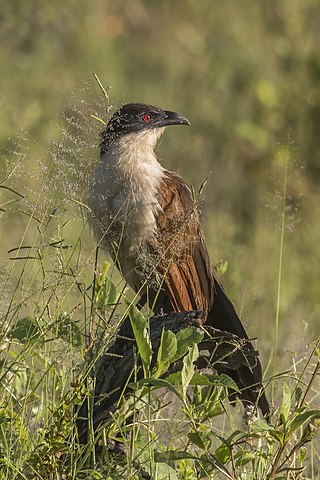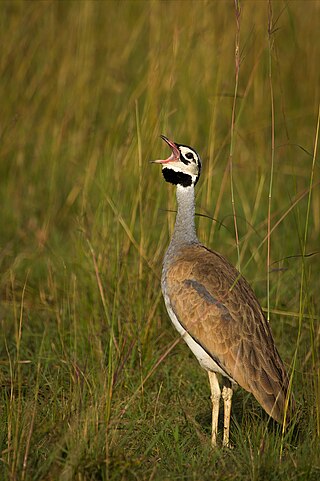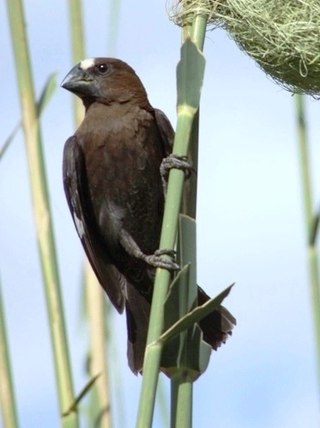
The African grey woodpecker is a species of bird in the woodpecker family Picidae. Is a widespread and frequently common resident breeder in much of Sub-Saharan and equatorial Africa. It is a species associated with forest and bush which nests in a tree hole, often in an oil palm, laying two to four eggs. It is a common bird with a very wide range, and the International Union for Conservation of Nature has rated its conservation status as being of "least concern".

The African paradise flycatcher is a medium-sized passerine bird. The two central tail feathers of the male are extended into streamers that commonly are more than twice as long as the body. The female tail feathers are of moderate length and without streamers. The upper parts of the male body, wings, and tail are boldly coloured in chestnut or rusty shades, but the underparts and the head are variably grey to blue-gray, with the head of the mature male being darker, commonly glossy black with greenish highlights. The beak and other bare areas, including a wattle ring round the eye, match the colour of the surrounding feathers. The female coloration is similar, though not so showy and glossy and with the head paler.

The yellow-fronted canary is a small passerine bird in the finch family. It is sometimes known in aviculture as the green singing finch.

The olive bee-eater or Madagascar bee-eater is a near passerine bee-eater species in the genus Merops. It is native to the southern half of Africa where it is present in Angola; Botswana; Burundi; Comoros; Democratic Republic of the Congo; Djibouti; Eritrea; Ethiopia; Kenya; Madagascar; Malawi; Mayotte; Mozambique; Namibia; Rwanda; Somalia; South Sudan; Sudan; Tanzania; Uganda; Zambia; Zimbabwe. It is a common species with a wide range so the International Union for Conservation of Nature has rated their conservation status as "least concern".

Strix is a genus of owls in the typical owl family (Strigidae), one of the two generally accepted living families of owls, with the other being the barn-owl (Tytonidae). Common names are earless owls or wood owls, though they are not the only owls without ear tufts, and "wood owl" is also used as a more generic name for forest-dwelling owls. Neotropical birds in the genus Ciccaba are sometimes included in Strix.

The cardinal woodpecker is a widespread and common resident breeder in much of sub-Saharan Africa. It occurs in a wide range of habitats, ranging from dense forest to thorn bush. It is fairly vocal and is easily identified by its call notes. The sexes are distinguishable by their head patterns.

The African yellow warbler, also known as Natal yellow warbler, dark-capped yellow warbler or yellow flycatcher-warbler, is a species of Acrocephalidae warblers; formerly, these were placed in the paraphyletic "Old World warblers".

The African goshawk is an African species of bird of prey in the genus Accipiter which is the type genus of the family Accipitridae.

The gabar goshawk is a small species of African and Arabian bird of prey in the family Accipitridae.

The coppery-tailed coucal is a species of cuckoo in the family Cuculidae. It is found in Angola, Botswana, the Democratic Republic of the Congo, Malawi, Namibia, Tanzania, Zambia, and Zimbabwe. It was first described by the German ornithologist Anton Reichenow in 1896.

Fraser's eagle-owl is a species of African owl in the family Strigidae. It is named after the British zoologist Louis Fraser.

The African green pigeon is a species of bird in the family Columbidae, and one of 5 green pigeon species in the Afrotropics. The species has a wide range in Sub-Saharan Africa with around 17 accepted races.

The white-bellied bustard or white-bellied korhaan is an African species of bustard. It is widespread in sub-Saharan Africa in grassland and open woodland habitats.

The thick-billed weaver, or grosbeak weaver, is a distinctive and bold species of weaver bird that is native to the Afrotropics. It belongs to the monotypic genus Amblyospiza and subfamily Amblyospizinae.

The cuckoo-finch, also known as the parasitic weaver or cuckoo weaver, is a small passerine bird now placed in the family Viduidae with the indigobirds and whydahs. It occurs in grassland in Africa south of the Sahara. The male is mainly yellow and green while the female is buff with dark streaks. The eggs are laid in the nests of other birds.

The little green sunbird, also called Seimund's sunbird, is a species of bird in the family Nectariniidae. It is sometimes placed in the genus Nectarinia. It is found in Angola, Cameroon, Central African Republic, Republic of the Congo, Democratic Republic of the Congo, Ivory Coast, Equatorial Guinea, Gabon, Ghana, Liberia, Nigeria, Rwanda, Sierra Leone, South Sudan, Tanzania, Togo, and Uganda.

The grey-rumped swallow is a species of swallow. It is the only member of the genus Pseudhirundo.

The tawny owl, also called the brown owl, is commonly found in woodlands across Europe to western Siberia, and has seven recognized subspecies. It is a stocky, medium-sized owl, whose underparts are pale with dark streaks, and whose upper body may be either brown or grey. The tawny owl typically makes its nest in a tree hole where it can protect its eggs and young against potential predators. It is non-migratory and highly territorial: as a result, when young birds grow up and leave the parental nest, if they cannot find a vacant territory to claim as their own, they will often starve.

The black bishop is a species of passerine bird in the family Ploceidae native to Africa south of the Sahara. Three subspecies are recognised.

The species was first described by Linnaeus in his Systema naturae in 1758 under its current scientific name. The binomial derives from Greek strix "owl" and Italian allocco, "tawny owl". Some early descriptions upon review were found to have somehow conflated the very different barn owl with the scientific name Strix aluco, which in turn engendered some confusion.






















